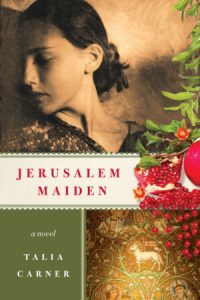Book Group Guide
The questions that follow are intended to enhance your group’s reading and discussion of JERUSALEM MAIDEN by Talia Carner.
Questions
1. “The Greenwald girl” represents a concept of a young woman who followed her heart—and her non-Jewish lover—and brought a chain of disasters upon her family. Discuss Esther’s action in light of this concept. Did she become “A Greenwald girl?”
2. Girls’ innocence and purity are sacred in the ultra-Orthodox world of Jerusalem Maiden. Even today, many women in religious societies—Jewish, Christian, Hindu or Islam—live in even worse oppressive enclaves both in the West and in the Middle East, Asia and Africa. What are the tools used to control them in various places? Do these women share responsibility for their own insulation? Can they change their fate? Should we interfere in their cultural or religious practices?
3. In Esther’s ultra-Orthodox society, adherence to all Commandments and decrees is paramount. Discuss the difference with what you know of today’s Jewish Orthodox societies in the USA—their child-rearing practices, education and the status of women.
4. Esther does not desert her faith. She only rebels against the religious establishment. Have you experienced that gap?
5. What kind of medical practices were available at the time of the story? Discuss the role of the midwife as a medical practitioner.
6. Discuss the relationship between Esther and her mother during Esther’s adolescence—and her view of that relationship as an adult. What were her mother’s expectations, and what were Esther’s?
7. When Aba recites Woman of Valor from the Book of Proverbs, Esther finds the expectations unattainable. What expectations exist today that reflect an unfeasibility similar to that of the Woman of Valor?
8. Esther felt she never belonged in her world—neither in Me’ah She’arim, nor in Jaffa. Was there anything she should have done differently? Was it “her, or them,” as Nathan asks?
9. Twice in the novel Esther physically emerges from a dark place where she connected with her ancestors—at Rachel’s Tomb and at Hezekiah Tunnel. Discuss the physical and spiritual illumination. Have you had similar experiences?
10. Was Mlle. Thibaux an early feminist, or was she just a “back-street” mistress? Discuss her character and her life’s choices. Would she have been a different person had she been married?
11. Esther’s marriage to Nathan was not a bad one. She was comfortable and safe. Yet she was willing to throw it all away. Discuss her character and her dissatisfaction with what would have been many women’s dream.
12. Esther’s relationship with guilt fluctuates as she ages, accompanying rebellion, acquiescence, indignation and impetuousness. Throughout her life, how do her desires produce guilt, and how does she reconcile it at each step?
13. Chaim Soutine is the one true-to-life character in this novel. Read about him and check out his art—and if possible travel the Philadelphia-based Barnes Collection.
14. Esther’s sojourn in Paris is supposed to be a vacation. Discuss the point at which it turns to abandonment of her children. Also, is her settling in Paris a betrayal of the Holy Land?
15. Even in today’s open, free society, many women do not follow their hearts or their dreams to discover “The Primordial Light.” Why? Discuss what it takes for a woman to focus and to fully develop her talents.
16. Relationship between sisters can be complex. Discuss Esther and Hanna’s, starting in their childhood and how their different personalities and choices played a role.
17. In the end, Esther gives up the only two things she loves and which let her be who she is. Discuss her double sacrifice. What kind of a woman will she be in Jaffa and what life will she have back there?

